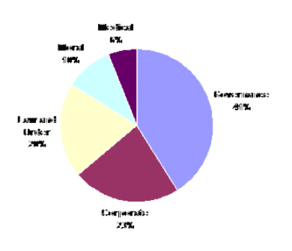The WAGER Vol. 7(39) – What is Black and White and Read All Over?
Narratives regarding gambling permeate our daily lives in the form of newspaper articles, television shows and radio programs. The media can reflect society’s developing attitudes; alternatively, the media actually can shape instead of reflect these attitudes. Either way, an examination of media content can provide an interesting glimpse into dynamic societal attitudes. With this intention, McMullan and Mullen (2001) examined newspaper coverage of casino and electronic gambling in a Canadian province. This WAGER reviews their descriptive analyses of dominant media themes.
McMullan and Mullen conducted a theme analysis on a random sample of 234 electronic and casino gambling-related articles published between January 1992 and December 1997 in Nova Scotia’s largest daily newspapers, The Chronicle Herald and The Mail Star. To identify underlying patterns in the sample of unique articles, the authors read and organized the articles by their significant content into distinct themes developed through previous research (Chermak, 1995; Ericson, Baranek, & Chan, 1991; Graber, 1980; Nickerson, 1995). The investigators recorded and summarized source variables for the articles (i.e. the name, position and organization of each cited source). In the second phase of data analysis, the researchers examined the role of the media, corporations, and the state in the construction of gambling news. Since a summary of the entire study is beyond the scope of this WAGER, we will limit this discussion to the first or thematic classification phase.
The newspaper articles were largely concentrated in the period leading up to the legalization of casino gambling in 1995 in Nova Scotia and the media promoted certain themes more heavily than other themes. The media gave the most coverage (41%) to narratives addressing the motives, actions and consequences of government policies on gambling. Reporters relied on a wide range of sources for governance articles, including government officials, consumers, business spokesmen, and religious leaders. Corporate discourse was also common (23%); a repeated theme among these articles was the positive impact of gambling on the local economy. Articles emphasizing legal regulations and enforcement comprised 20% of the coverage. Articles placing gambling in a primarily moral discourse were less frequent (10%); however, 78% of all articles had an underlying moral narrative. Commentary by religious leaders, self-help groups, and anti-gambling advocates usually emphasized the “evil” nature of gambling. Articles addressing the medical consequences of gambling were rare and represented only 6% of the coverage; thus, public perception might be that that disordered gambling is a trivial problem. These articles predominantly dealt with problem gambling and frequently quoted psychologists, health educators and self-help advocates.
Figure 1. News Article Discourses (McMullan & Mullen, 2001)
By restricting their study to two local newspapers and specific games, the researchers created an in-depth portrait of gambling coverage in one community but limited their ability to generalize these results to other regions and types of gambling different from those in the community studied. For example, the 1990s saw extensive changes in Nova Scotia’s gambling policy (e.g., electronic gambling was legalized in 1991 and casinos in 1995); the dominance of governance-themed articles might be directly linked to these dynamic regional events. In addition, the newspapers are jointly-owned and staffed; therefore the articles surveyed might represent work by only a handful of reporters and be biased by individual reporter preferences. The personal biases of the researchers coding the articles might also have influenced the results. The authors did not identify the parties responsible for coding so we do not know whether they were independent judges or the authors themselves. Finally, the authors did not make reference to efforts to control for personal biases or mention any measure of coder reliability.
Despite its limited scope, this research is notable because it identifies some general themes that are associated with news coverage on gambling. This research begins to unravel the process of news making by identifying the sources of information used to support particular themes. While the media can be a reflection of public interests, it also might be a vehicle to shape public perception. Researchers have already shown that treatment resources for substance abuse are associated more closely with media reports than prevalence rates (Schlesinger & Dorwart, 1992). Indeed, the media can turn anecdotes into social influence, with out regard for scientific support. With this in mind, anyone involved in gambling policy or research should be aware of the influence the media can exert and the potential affect it can have on their work.
Comments on this article can be addressed to Rachel Kidman.
References
Chermak, S. (1995). Victims in the News: Crime and the American News Media. Boulder: Westview.
Ericson, R., Baranek, P., & Chan, J. (1991).
Representing Order: Crime, Law and Justice in the News Media. Toronto: University of Toronto Press.
Graber, D. (1980). Crime News and the Public. New York: Prageger.
McMullan, J., & Mullen, J. (2001). What Makes Gambling News? Journal of Gambling Studies, 17(4), 321-352.
Nickerson, N. (1995). Tourism and Gambling Content Analysis. Annals of Tourism Research, 22(1), 53-66.
Schlesinger, M., & Dorwart, R. A. (1992). Falling between the cracks: failing national strategies for the treatment of substance abuse. Daedalus, 121(Summer), 195-237.
